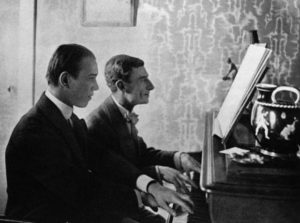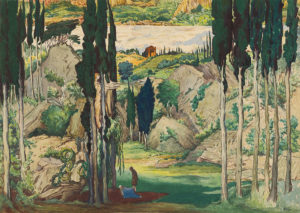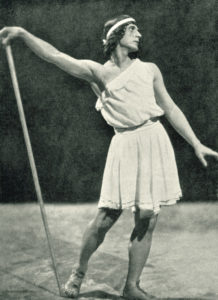The idea for a ballet based on Daphnis and Chloe (an ancient Greek love story attributed to Longus) originated with the Russian choreographer Michel Fokine. He first proposed the subject to the Director of the Russian Imperial Theaters, but it was not until Fokine became involved with Sergei Diaghilev’s groundbreaking Ballets russes in Paris that the idea became a reality. Maurice Ravel, one of France’s leading composers, was sought out as a collaborator. Fokine recalled, “I was delighted that a musician of such talent was going to write music for my Daphnis ballet, and I felt that the music would be unusual, colorful and, most important, what I sincerely wished—totally unlike any other ballet music.”

Shortly after talks began in 1909, Ravel wrote to a friend, “…I’ve just had an insane week: preparation of a ballet libretto for the next Russian season. Almost every night, work until 3 a.m. What complicates things is that Fokine doesn’t know a word of French, and I only know how to swear in Russian. In spite of interpreters, you can imagine the savor of these meetings.” Eventually they did come to an agreement about the plot of the ballet (which bore little resemblance to the original story), and Ravel set to work. The project was beset with a number of problems and delays, and was nearly cancelled. Diaghilev seems to have lost interest in it, preferring to concentrate on Prelude to the Afternoon of a Faun, a ballet choreographed by Vaslav Nijinsky, the star of the Ballets russes (and Diaghilev’s lover). Despite mixed reviews at the 1912 premiere, Daphnis is now recognized as Ravel’s greatest masterpiece.

Ravel referred to Daphnis as a “choreographic symphony” rather than a ballet, saying that it was “constructed symphonically, according to a strict plan of key sequences, out of a small number of themes, the development of which ensures the music’s homogeneity.” He further explained that “My intention in writing it was to compose a vast musical fresco in which I was less concerned with archaism than with faithfully reproducing the Greece of my dreams, which is very similar to that imagined and painted by the French artists at the end of the eighteenth century.” Indeed, the opulent orchestrations and sensuous melodies of Daphnis create a dream-like atmosphere of unsurpassed beauty.
In the first two acts of the ballet, Daphnis and Chloe fall in love, and Chloe is abducted by a band of unsavory pirates. When Daphnis discovers that Chloe has been kidnapped, he collapses near a grotto sacred to the god Pan. Nymphs entreat the deity to rescue Chloe, which he does.
The music of the Suite No. 2 is essentially the final scene of the ballet, but for orchestra alone (the original score includes a wordless chorus):
After one of music’s most famous sunrises, shepherds appear to wake Daphnis, who is still mourning the loss of Chloe. From their midst, Chloe emerges and the shepherds throw the couple into each other’s arms. Seeing Chloe, Daphnis realizes that the dream he had about Pan’s intervention was prophetic as the sunrise music returns even more resplendent than before.

An oboe solo represents the old shepherd Lammon, who tells them that Pan was moved to rescue Chloé because he once loved the nymph Syrinx. Daphnis and Chloé then reenact the myth. A trio of two oboes and English horn accompanies Chloe as Syrinx wandering in a meadow. The string’s response represents Daphnis as Pan declaring his love. A dialogue between woodwinds and strings shows Syrinx’s rejection of Pan’s advances. When Syrinx vanishes, transforming herself into some reeds, Pan fashions them into a flute and begins to play. The following flute solo accompanies a dance by Chloé. The dance becomes faster and faster until Chloé, spinning out of control, falls into the arms of Daphnis. After a violin solo, Daphnis makes an offering of thanks at Pan’s altar accompanied by solemn trumpets. Suddenly, a group of young women dressed as bacchantes enters playing tambourines. A group of young men follows, exhorting all gathered to rejoice.
Ravel was stumped by the task of bringing his ballet to a conclusion. At one point, he became so discouraged that he asked Louis Aubert (who wrote the Habanera on this program) to write it for him. Aubert refused. According to Ravel’s student, Manuel Rosenthal, Ravel later confessed that “Yes, I was in a very bad mood over it, so much so that I put Rimsky’s Sheherazade on the piano and tried, very humbly, to write something like it.” Though listeners familiar with Rimsky-Korsakov’s tone poem may recognize one prominent melodic quotation (compare this with this), in truth the self-effacing Ravel did far more than imitate his model. The finale is a triumph of Dionysian rhythms, featuring shifting, irregular meters. A whirling celebration of pagan love, it is one of music’s most exhilarating endings.
Don’t miss Ravel’s Daphnis and Chloé Suite No. 2 on February 2, 3 and 4, 2018! Get tickets and more information at houstonsymphony.org.



